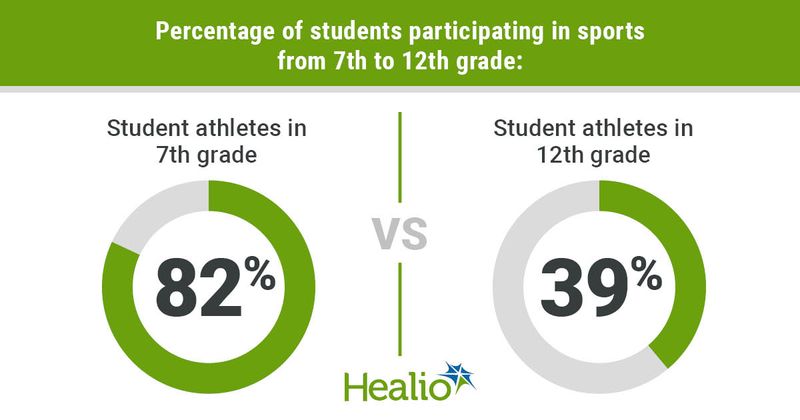Sports participation, physical activity declined from middle school to high school
Click Here to Manage Email Alerts
Key takeaways:
- The number of days students engaged in 60 minutes of strenuous exercise decreased from 7th grade to 12th grade.
- More students in 9th grade stopped participating in a sport compared with all other grades.
Results showed a decrease in sports participation and physical activity from middle school to high school, with a significant number of students specializing in a single sport or no longer participating as they entered high school.
“We all need to work together to change this for kids,” Bianca R. Edison, MD, MS, sports medicine specialist at Children’s Hospital Los Angeles, told Healio. “This study highlights the fact that we may be having misguided priorities for our kids to participate and play in sports.”

Decrease in sports participation
Edison and colleagues performed a longitudinal survey of the graduating class of 2023 in the fall of each school year from 7th to 12th grade about sports participation, specialization and burnout. Researchers analyzed responses from 126 students by grade level using mixed-effects linear and logistic regression models that accounted for repeated measures.

Results showed a progressive decrease in the number of days per week in which students engaged in at least 60 minutes of strenuous exercise from 4 days per week in 7th grade to 2.3 days per week in 12th grade.
“The transition from middle school to high school served as a crux. And a key crux and time point that changed things, particularly from a physical activity participation perspective, is that we saw a drop-off as they went through high school in regard to being physically active. That went from an 82% participation rate in sports down to 39% once they hit high school,” Edison said.
Although the percentage of athletes spending at least 75% of their time in a single sport did not differ significantly across grade level, researchers noted more students in 9th grade stopped participating in a sport, quit a sport to focus on a single sport or reported that one sport was most important to them compared with all other grades. For those participating in sports, the average hours per week spent in sports increased from 5.4 hours per week in 7th grade to 11.9 hours per week in 12th grade.
Burnout in school, sports
Results showed burnout in school was more common in high school vs. 8th grade, and this finding was statistically significant. Although burnout in sports did not differ significantly by grade level, Edison said, “It was still considerable in that almost one in five to one in four of these students, based on the particular years, have sport-related burnout.”
While the results of this study identified which school-aged athletes may experience burnout, Edison said she hopes to identify why student athletes may feel this way in future research. Based on anecdotal evidence, Edison said some reasons may include overscheduling activities, high expectations that are externally or internally driven, and the amount of competitive play and involvement in training.
“Our ultimate goal should be that kids need to learn all of these skills that sports provide, and they are such rich skills about team playing, working with others that are different than you, learning how to get up from a setback, time management [and] leadership,” Edison said. “Those should be our guiding lights, ones we should work so hard to protect and make sure that everyone gets the opportunity to play sports, stay in sports and not get burnt out.”

